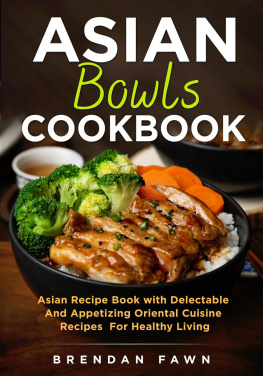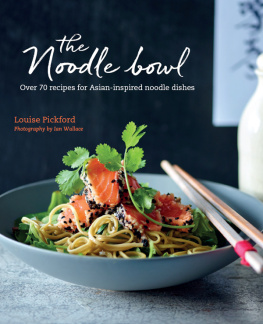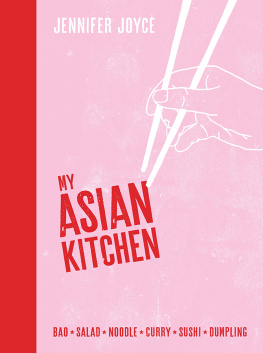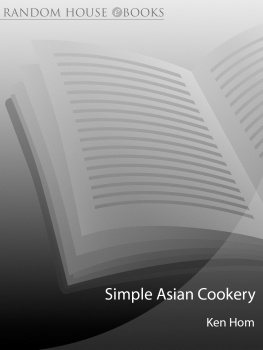BIG BOWL
NOODLES AND RICE

BRUCE COST
WITH CHEF MATT McMILLIN
PHOTOGRAPHS BY ZEVA OELBAUM

For Jennifer, Eliza,
Ben, and Madeline
S imply stated, this book is a collection of appetizers, noodle dishes, and stir-frys for the home cook, adapted from the menu and specials of the popular Big Bowl restaurants. Because of my own history with this food, however, Id like to go beyond that and put the book and the restaurants that spawned it in historical perspective.
What follows will be a little personal, but Ill state from the outset that whatever success the Big Bowls enjoy can be found in the timely combination of the food Ive loved, cooked, and promoted for around three decades with the expertise of the restaurant group Lettuce Entertain You that has been honing its skills for just about as long.
Thirty years ago Asian food occupied a small, exotic niche in America. In New York where I was living, people had just discovered there was Chinese cooking other than Cantonese-American. The first Sichuan restaurants opened and, since Americans seemed to like spice, Hunan restaurants followed. To distinguish their food from Cantonese, Chinese restaurants offered what they called Mandarin cooking. Dishes such as Hot and Sour Soup, Mu Shu Pork, and General Tsos Chicken replaced Sweet and Sour Pork and Egg Rolls. Dim Sum restaurants opened in big-city Chinatowns and, if you knew where to go, it was possible to get decent renditions of Shanghais famous soup dumplings, shaolin bao, or a Taiwanese breakfast featuring yu taio (fried crullers) served with doujiang (salty soybean soup). Even the fare of the Chinese Hakka people, whose hardscrabble existence as itinerant field workers led them to subsist imaginatively on delicacies such as spinal column, dried fish lips, various pickles, and a lot of bean curd, could be found, modified for American tastes, in newly opened Hakka restaurants on both coasts.
We discovered new Chinese provinces through new restaurants offering that food, likewise the countries of Southeast Asia. People discussed the differences between Thai and Laotian cooking, no matter that there was a shaky connection between what was served on these shores and the native cooking. At the time, a friend who is an Asian-languages scholar led a tour of people mostly from the Upper West Side of Manhattan to Chengdu in Sichuan, China, where they had a banquet. In that part of New York an average of one restaurant per block had opened billing itself as Sichuan, so these people were sure of themselves when they proclaimed, loudly, that what they were being served in Chengdu was not Sichuan food.
While gaining wider and wider exposure to mostly urban Americans, until recently Asian food hadnt really made a leap into the mainstream. Still served for the most part in inexpensive ethnic venues in Asian enclaves in big cities, the Asian food in these restaurants simply expanded the Asian-American repertoire.
Until recently, those of us who spent the past twenty to thirty years cooking and writing about Asian food were a tiny, not-quite-legitimate minority. We watched Italian food move on from the fare served on red-checkered tablecloths at Italian-American restaurants to the authentically regional in newly designed restaurants by owners with no Italian heritage. Mediterranean-style food with its emphasis on fresh, fine ingredients was wholeheartedly adopted and became California or New American cooking as young American chefs, olive oil in hand, made this food our own.
For whatever reasonexposure to Asian food via new immigrants, travel to Asia, saturation of Mediterranean-style cooking, a new generationtimes have changed. Young American cooks are opening restaurants featuring Asian food and, if not, theyre adopting Asian ingredients into their cooking. It makes sense since were talking about the worlds oldest, most varied cuisines. Although its the last substantive niche to be explored by our cooks, adopting techniques and ingredients that have been enjoyed by billions over millennia is a pretty safe bet and is, perhaps, inevitable.
As I write this, its Tuesday night at Big Bowl, and Ive just picked my way through a throng of young Chicagoans, many of whom will wait up to an hour for the opportunity to enjoy fresh Chinese egg noodles with peanut sauce, or stir-fried with blackened chiles and chicken; hand-cut Shanghai Noodles with Vegetables and Eggplant (page 86); Pad Thai rice noodles with shrimp; beef with Chinese broccoli in Shaoxing rice wine sauce; and a real Kung Pao chicken with fermented chili paste and whole bean sauce. Not far away in Minneapolisin this nations heartlandpeople are packing into a Big Bowl there.
I mention this not so much to boast, but as an expression of amazement at what appears to be a profound shift in the taste of Americans, particularly the young and educated. After a 2,100-year reign as Asias most beloved man-made staple, noodles would seem to be on their way to becoming American, like pizza. At Big Bowl we know this not only from trade magazine articles about the proliferation of noodle shops and other Asian restaurants in New York, California, and increasingly across the land but because, as of this writing, the customers at four restaurants are slurping down one ton of Chinese egg noodles, Shanghai wheat noodles, and two kinds of slippery rice noodles every three days. They also take them out, and we deliver them to their door.
For those unfamiliar with Big Bowl, the menu offers about seventy-five items-mostly noodles (five kinds), stir-fries, and little dishes to sharewith additional specials that change weekly. If the customers need heat, they find on the table a fiery condiment that we make every couple of days from fresh and dried chile peppers. We squeeze lemons every day for use in our Thai dishes, and our Thai curry pastes are made from scratch starting with the toasting and grinding of whole spices. We even make the ginger ale from fresh ginger.
Why this book? It was suggested that much of the appeal of Big Bowls food is the feeling, I can make this. Its authentic and accessible at the same time. Its fresh and healthy, full-flavored Chinese and Southeast Asian food, much of it meal-in-a bowl. Its food that translates easily to the home kitchen. Were hoping the book is useful for those who cant always get to Big Bowl. We want to share because all we really try do is serve great home-style cooking in a restaurant.
(What Youll Need to Know
to Cook from This Book)
FRESH INGREDIENTS
Herbs and Fresh Seasonings
THAI OR ASIAN BASILa tropical variety of sweet basil with small green leaves, purple stems and flowers, and a wonderful basil/anise flavor; the Thais call this bai horapa and the Vietnamese, rau hung. Available in Southeast Asian markets year round, it can be stored for a couple of days in the refrigerator with the stems in water and leaves loosely covered with a plastic bag.
MINTYou may use any fresh spearmint for the recipes in this book. Southeast Asian markets carry a fuzzy-leafed tropical variety sold in bunches with stems up to a foot long. Unlike its cousin, basil, mint is not usually cooked; rather its used in salads.
Next page






